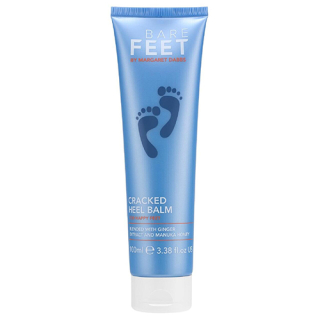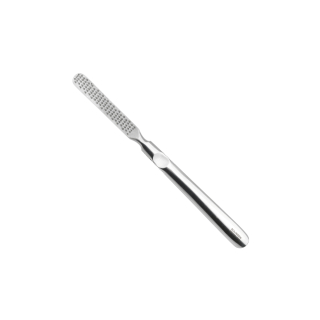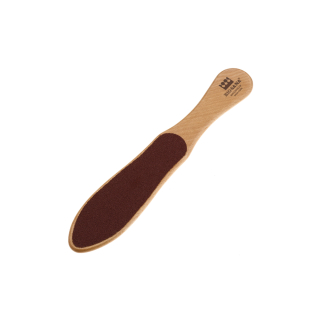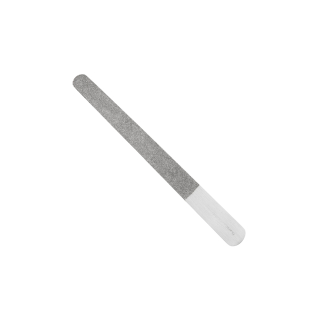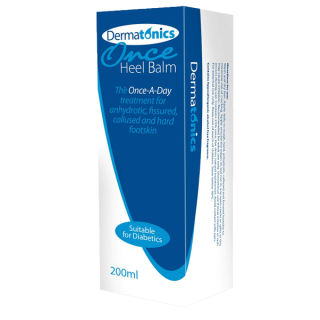Cracked heels
Cracked heels, also known as fissures, appear due to general dryness around the heel of your foot.
This is caused by pressure on the fat pad of the heel causing it to spread sideways stretching the skin, leading to splitting or cracking of the callus.


Common causes of cracked heels
- Dry skin due to cold temperatures or low humidity
- Vitamin deficiency
- Walking barefoot
- Taking long, hot baths and using harsh soaps
- Standing for long duration
- Wearing ill fitting shoes
- Pregnancy
- Aging
How to treat cracked heels
- Use a pumice stone or other foot file to help reduce the thickness of the skin when in the bath or shower. DO NOT use a razor blade to take away the hard skin.
- Follow this treatment with the use of a good foot cream in order to moisturise the area and keep it supple. Use frequently i.e. once or twice a day.
- You may be advised to use a cream specifically for dry heels as this contains a chemical called urea which helps to keep moisture in your skin, prevents evaporation.
- Use the foot cream at night and wear bed socks to help the foot absorb as much of the cream as possible.
- Seek professional help for the Fissures, to help with the healing as this may require debridement.
- Insoles, heel pad or heel cups to redistribute the weight of the heel and provide better support (prevent the fat pad from expanding sideways).
What Are Cracked Heels?
Cracked heels describe the appearance of fissures (cracks in your skin) and general dryness around the heel of your foot.
What Causes Cracked Heels?
Pressure on the fat pad of the heel causing it to spread sideways. This stretches the skin, leading to splitting or cracking of the callus.
What Are The Symptoms Of Cracked Heels?
- Development of a callus around the heel
- Small white lines appearing in the callus
- Roughness of the callus
- Pain on standing, walking or pressure to the foot.
- Bleeding from the cracks
- Cellulitis from the cracks (fissures) becoming infected
Who Is At Risk Of Getting Fissures?
People with the following conditions are at higher risk of getting cracked heels:
- Diabetics, as you may have neuropathy (numbness) or poor circulation. This means you may not feel the development of the fissures, nor them opening into a cut. A cut can allow bacteria in, which could potentially cause an infection.
- Poor circulation
- Immune-compromised from medical treatments
- Atopic Dermatitis
- Juvenile plantar dermatosis
- Psoriasis
- Hypothyroidism
- Carrying excessive weight or obesity
- Prolonged standing on hard floors
Additionally, those who wear open-backed shoes, sandals and flip flops are also at risk. This is because they can’t support the fat pad of the heel. Additionally, they increase the pressure applied to the fat pad, causing it to expand.
Cracked Heel Treatment Products
Skincare To Soothe & Repair Cracked Heels
The key to soothing dry, cracked heels is keeping a consistent skincare routine, which may seem complicated. That’s why we’ve made it simple for you by putting all the products you need in one place. You can create a transparent barrier with cracked heel sealer to prevent existing cracks from deepening. Or, you can exfoliate and renew dead, dry skin with a nourishing daily balm.
Pamper Socks To Lock In Moisturiser Benefits
After your nighttime foot skincare routine, why not use Gelx Gel Pamper socks to lock in the benefits? The socks not only help seal in much-needed moisture, their unique gel lining releases nourishing skin hydrators. This makes them a staple for dry, cracked heels.
Foot Files To Remove Dry, Cracked Skin
Removing dead skin has never been easier than with our selection of foot files. They remove lingering dry skin gently but effectively, so that you don’t do any further damage. Our selection of files are podiatrist-recommended; alongside a consistent skincare routine, they’ll keep your skin looking and feeling strong and smooth.
Shop the range to build your perfect cracked heel care routine today!
Cracked Heel Treatment & Repair
Remove Dead Skin & Moisturise
Use a pumice stone or other foot file to help reduce the thickness of the skin when in the bath or shower. DO NOT use a razor blade to take away the hard skin. You should follow this treatment with the use of a good foot cream, in order to moisturise the area and keep it supple. Use it frequently i.e. once or twice a day.
You may be advised to use a cream specifically for dry heels, as this contains a chemical called urea. The chemical helps to keep moisture in your skin and prevents evaporation, meaning you can reap all the benefits.
Use the foot cream at night, and wear bed socks to help the foot absorb as much of the cream as possible.
Always Seek Professional Guidance
Additionally, you should seek professional help for the Fissures, to help with the healing. This is because you may require debridement (a medical procedure to remove the damaged skin). A podiatrist can advise you with the best possible treatment for your condition.
Use Padding To Protect The Heel
Insoles, heel pads or heel cups can help to redistribute the weight of the heel and provide better support, to prevent the fat pad from expanding sideways.
Shop the range to soothe pain from cracked heels and stop them in their tracks!
Cracked Heel Treatment FAQs
What Is The Fastest Way To Heal Cracked Heels?
The fastest way to heal cracked heels is using methods such as exfoliating, moisturising and soaking affected areas. You can also employ heel pads or cups to help redistribute the weight of the heel. This will stop future occurrences of cracked heels. It is always recommended that you seek professional help for the fissures. This will allow you to determine the most effective healing method.
Should You Walk On Cracked Heels?
It is not necessary to stop walking entirely with cracked heels, however, walking can exacerbate the condition. That’s why it’s important to seek podiatrist advice for the best possible treatment. You can also exfoliate and moisturise the skin, as well as using heel pads in shoes to avoid the fat pad of the heel expanding. This will help prevent future cracked heels.
Do Cracked Heels Ever Heal?
Cracked heels can heal when treated with a comprehensive combination of heel supports, skincare and expert advice. However, the speed and effectiveness of recovery depends on how well you stick to the recommended treatment plan.
Can Cracked Heels Be Healed Permanently?
This depends on your ongoing foot care practices and the underlying causes behind your cracked heels. You can help minimise future recurrences using methods such as heel supports and keeping up with exfoliation and moisturising.


